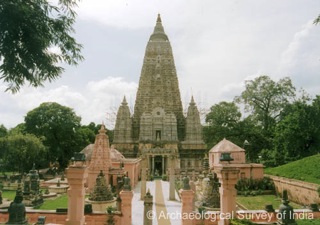PDC in the Heart of Bodhgaya, India this Spring
2 views
Skip to the first unread message
Living Mandala
19 Feb 2012, 17:05:4319/02/2012
to
Dears Friends,
We are inspired to be holding this unique and very affordable PDC in theBuddhist pilgrimage city of Bodhygaya, India this Spring.
The intention is to not only provide a high quality, information-filled, and hands-on immersion experience for participants; but also to support the on-going efforts of sustainable development in Bodhgaya by the humble people, activists, and Buddhists monks & nuns in the local community.
Please help us spread the word about this unique and very affordable course to westerners who may be traveling through India this Spring looking for a quality course and life-changing experience at this unique setting.
More Info Below.
-The Living Mandala Team
____________________
Permaculture Design Certification Course
in the Heart of Bodhgaya, India
25th March to 8th April, 2012
Sikkim House / Monastery, Bodhgaya, India
Only $175 - $525 US!

In Association With
Rico Zook & Support Staff
Course Description
Learn all about sustainability and receive your Permaculture Design Certificate in the setting of the sacred city of Bodghaya and its many monasteries, pilgrims and seekers who travel from all over the world to this place of the Buddha’s Enlightenment. Do hands-on projects, face challenging exercises, do a permaculture design, and learn about the many facets of creating a sustainable lifestyle while benefiting the local community and the efforts for sustainability in Bodhgaya. This is a full immersion experience that will change your outlook and your life forever, as you begin to build a life of resiliency.
Using a variety of learning techniques and strategies this course presents Permaculture as an integrated design approach to create sustainable human habitat. Course time will consist of traditional lectures, guest presentations, group discussions, games, exercises, hands-on projects, photos, movies and site visits. While we will focus on land systems, many discussions and examples will be explored of applications in the 'Invisible Structures'. These are the social, cultural, political, and economic structures we create as humans that powerfully shape much of our world today. Not only will the course be about Permaculture, but it will also model it by its structure and the environment we create together during the course.
During the latter part of the course design teams will be formed and given real life design assignments that are relevant to the course venue. The course will culminate with each team giving presentations of their designs to the class and interested local people and groups. These designs will be left with venue to become valuable resources for them. Elements to whole sections of past student designs have been incorporated by many sites were this course has been hosted.
Join this course and be prepared for a life changing experience which will leave you much more prepared to respond to the global changes that are starting to happen with solutions, resiliency, and compassion.
The course will cover the soil food web, soil food web analysis, composts and compost extracts, and the use of microscopes.

Bodhgaya, India - The Place of the Buddha’s Enlightenment
Bodhgaya in northeastern India, is one of the most spiritual places in the Buddhist world and also an UNESCO WHS accredited town. Bodhgaya is the site of the Buddha's enlightenment and the most important of four main Buddhist pilgrimage destinations. Known as Uruvela in the Buddha's time, the city of Bodhgaya is now a town of about 30,000 permanent residents. The two major sacred sites in Bodhgaya are the Mahabodhi Temple and the Bodhi Tree, around which many other temples and monasteries of various Buddhist traditions (Japanese, Tibetan, Bhutanese and others) have been built. Every year, millions of Buddhist pilgrims flock to Bodhgaya to be inspired, dissipate negative karma and earn merit by visiting the holy site where the Buddha became the Buddha - the "Enlightened One." There are many other sacred sites located nearby including Mahakala Cave and others. It is rich in culture and an international gateway, the busy winter season is frequented by pilgrims and visitors from all over the Himalayas and the world.
Who Should Take This Course?
This course is both for those who want a general but comprehensive introduction to sustainability and how to create it, for those wishing to get a complete and in depth introduction to permaculture, all its component elements, and the process and methodologies for creating a holistic permaculture design, and for those who people traveling through India who want to experience a truly life changing course that will give you skills and a design framework you can take with you the rest of your life to any country, continent, and ecosystem on the planet. We expect the course will be filled half with International travelers, and half with Indian Nationals. It is especially beneficial for farmers, ranchers, teachers, designers, all types of agriculturalist, architects, urban planners, engineers, resource managers, and anyone else who works with our physical world or does design work in its many forms. However, one does not need to be going into a permaculture career or a related field to benefit from this training. Many artists, medical professionals, business people, housewives, cooks, international travelers, and others have gained insights, understandings and powerful life, changing experiences that have enabled them to both increase their quality of life, as well as move all their endeavors towards creating a more sustainable world.
Supporting Sustainable Development With Local Communities in Bodhgaya
This workshop will culminate with several groups doing a real life design projects that will be relevant to the site of the workshop. Not only will the teaching be about Permaculture, but it will also model it by its structure and the environment we create together in the course. This workshop will contribute to the enrichment of its site and each of its participants. With the goal of having half international students and half local students this workshop will not only be an opportunity to learn about Permaculture, it will also offer an opportunity to understand we can create a regenerative, sustainable world together. The person attending the Permaculture Design Course will not only gain theoretical and practical knowledge on Permaculture at the end of the workshop but will be handed a Permaculture Design Course Certificate. This certificate will enable the participant to be a certified Permaculture Practitioner.
From its inception Permaculture has quickly spread to over One hundred and twenty countries where farms and other sites are successfully applying its' ideas, techniques and strategies. As further testament to its applicability, Permaculture is now being applied in many urban and suburban areas. In many developed countries these applications hold much promise for dealing with the many issues associated with mass populations.
What is Permaculture?
Permaculture is a design system to create regenerative, sustainable systems. Envisioned over 25 years ago by Bill Mollison and Dan Holmgren, from Australia, it has now spread to over 120 countries. Though its conception was as a land based system, its effectiveness has moved it into urban settings and to being applied in various social, political, and economic environments. Permaculture was created through the synthesis of many design systems, with the emphasis on nature as the penultimate one. Similarly, the insights and value of traditional and indigenous practices and knowledge are acknowledged along with the necessity of molding these with our current understandings and the appropriate technologies of today's world. What Permaculture seeks to do is to create three-dimensional designs that are site specific and sustainable. By bringing together elements (orchard, water system, farmer, cow, etc.), techniques (organic framing, natural building, etc.) and strategies (microclimate, relative placement, etc.) a system is designed or altered based on regenerative relationships. It is these regenerative, beneficial relationships that give a system complexity, three dimensionality, and thus, resiliency.
About Sacred Earth Trust
Sacred Earth Trust is a not for profit organisation set up since 2009 to support and encourage the sustainable development and environmental protection of Sacred sites and UNESCO world heritage sites around the world, through working in co-operation with the local, indigenous people and international groups.
e-mail: educ...@livingmandala.com
Phone: (707) 634-1461
Living Mandala
Organizing Education, Events & Initiatives for Personal & Planetary Transformation
Reply all
Reply to author
Forward
0 new messages
